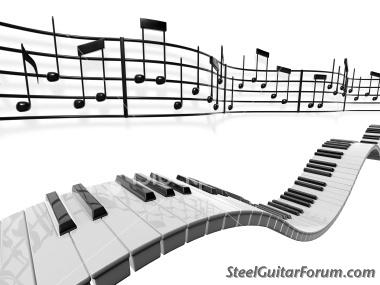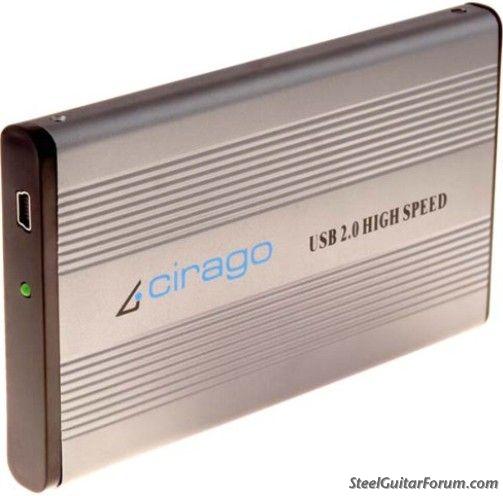Folks, I think I answered my own question
168.
If you are wondering how to use the programs on the hard drive, there are a few different options you have.
Use the hard drive "as is" and run the programs from it. The easiest way is simply to run the "pre-installed" programs directly from the hard drive. You should first double-click on the small Setup.exe on the root level of the hard drive. You would only need to do this once, and it will install a few things that need to be registered on your computer. Then you can run any program directly from the hard drive by double-clicking on the program launchers in the PGMusic folder. For example, to run Band-in-a-Box, open the PGMusic folder and double click on the Band-in-a-Box.exe launcher.
Or, copy the PGMusic folder from the USB hard drive to your computer and run the programs from there. You may wish to copy everything to a different hard drive, for example your computer's C: drive. Then you could either use the USB drive for another purpose, or just use it as a backup (recommended). The best way to do this, is to first run the small Setup.exe program on the root of the USB hard drive, then copy and paste the entire PGMusic folder to where you want it on your other hard drive. Note that this could require over 100 GB of free hard disk space (depending on which HD you got and when you got it). Right-click-properties on the PGMusic folder to find out the size, or check the ReadMe file on the root level of the hard drive. It will probably take a couple of hours to copy. To run the programs, you can use the launchers within the PGMusic folder. You could also create desktop shortcuts to the programs etc.
Note that if you have an "Audiophile" version of the hard drive (with all of the uncompressed wave files), this will take up a very large amount of space on your hard drive; you may want to consider the third option discussed below.
Or, install the programs on your computer, but leave the RealTracks and RealDrums on the USB hard drive. We include some installers on the hard drives, in case you want to install the program(s) to your hard drive like you've done in the past. Note that the RealDrums and RealTracks audio files aren't included in the installers. One advantage in doing this, is that if you have a previous version of Band-in-a-Box you are upgrading, you can install the new version of Band-in-a-Box to the same folder. You don't need to copy the RealTracks and RealDrums folders - you could instead set custom RealDrums and RealTracks folder locations in the Preferences dialogs in Band-in-a-Box. Then you can use Band-in-a-Box as you normally would, running it on your computer hard drive, while keeping the large audio files on the USB hard drive. Note that it's possible that the drive letter for your USB hard drive will change - for example if you unplug the drive, then add or remove other USB devices, then plug it back in. In this case, you would need to re-set the correct custom folder.
Another way you could copy Band-in-a-Box to your computer's hard drive and leave the RealDrums/RealDrums on the USB drive, is to copy the entire contents of the bb folder except for the RealDrums and RealTracks folder. To do this you could open the bb folder, Edit-Select All, hold down the ctrl key while clicking on the two folders, then copy and paste.
If your computer does not recognize the hard drive, it is most likely a power supply issue. Different computers and laptops deliver more/less power to the USB ports.
On one end of the USB cable, there is a second USB connector you can use for extra power (usually a little smaller than the main one). If your cable looks like that, first make sure you have the larger connector plugged into your computer. It is *normally* only necessary to use the one plug.
If that doesn't work, try connecting the main plug directly to a USB port on the back of your computer, rather than a USB hub or ports on the monitor/keyboard/front of the computer case. Unless you have a self-powered USB hub (i.e. one that plugs into the wall, or battery-powered) it doesn't have any more current drive than is available on its usb connection to the mother-computer. So each single port on a hub often doesn't have enough power to drive some devices. USB ports on the front of your computer etc. can be similar to this.
You could try connecting the extra power USB plug to another port (so you have both cables plugged in). Note that there is often a maximum current available per pair of vertically stacked USB ports, so you may have better luck bridging between two pairs. Also, if you have other USB powered devices that require alot of power, such as audio interfaces or a MIDI keyboard, it would be best if each of those had its own pair.
The default power management for many laptops, is set to power-off the external power to USB ports when they go to sleep. On some computers it can even be set up to deliver less power or no power if you are running off the battery. It is a good idea to look at the options in the control panel 'power' settings and/or My Computer-Hardware control panel.
If you have Windows Vista and you are getting errors when running programs from the hard drive, it may be because User Account Control is enabled on your computer. The simplest solution is to disable User Account Control. This is done in the Windows control panel | User Accounts. If you do not want to disable User Account Control for some reason, then the best solution is to install the program to your computer's hard drive, and run it from there. You can still leave the RealTracks and RealDrums files on the USB hard drive, and that will work fine as long as you have Band-in-a-Box 2009 Build 280 or higher. If you don't want User Account control enabled for your account, but you want it enabled for other users on the computer, there are online tutorials that describe how you can do this.
Some other general points.
When you first plug the HD in, Windows may ask you what action you want to take. You can either close that window, or choose 'Open folder to browse files'. Either way, you can access the HD through My Computer. On most of the hard drive enclosures there is a small LED which is green if the unit is receiving any power, and red (or flashing red) if it is transferring data.
You should use the Safely Remove Hardware icon in your taskbar (bottom right side of your computer screen) before physically disconnecting the drive from your computer. If that doesn't work (you get a message saying that it can't be stopped), make sure the drive isn't in use, by closing programs and windows on the disk. (If it still doesn't work, you should reboot before disconnecting).
You can install updates and patches to the programs in the same way that you would normally, except that the update patch installers will not necessarily be able to locate the destination folder automatically. Make sure to select the correct destination location. For example, if the drive shows as the G: drive, you would install a Band-in-a-Box update to G:\PGMusic\Programs\bb. For PowerTracks, you would install to G:\PGMusic\Programs\pt.
This is off the BIAB FAQ page on their website. For what it's worth.
Mack
76 Emmons Push Pull, Williams 600, ShoBud Pro I, MSA Classic, Remington SteelMaster dbl 8, MSA Super Slide dbl 8, Gold Tone 6, And other instruments and equipment I can't afford.

